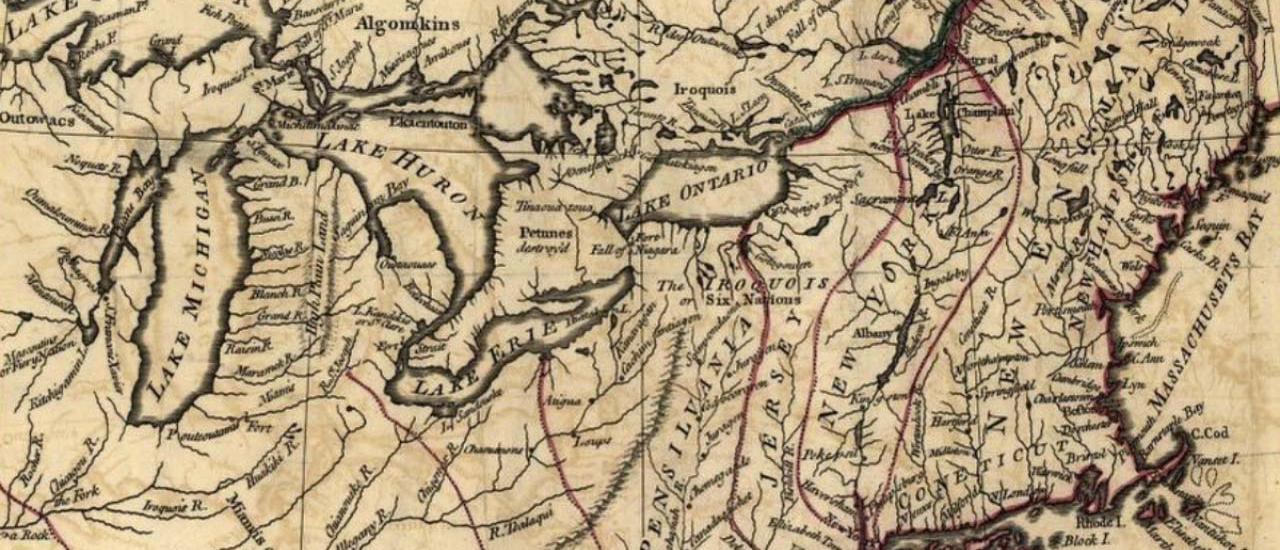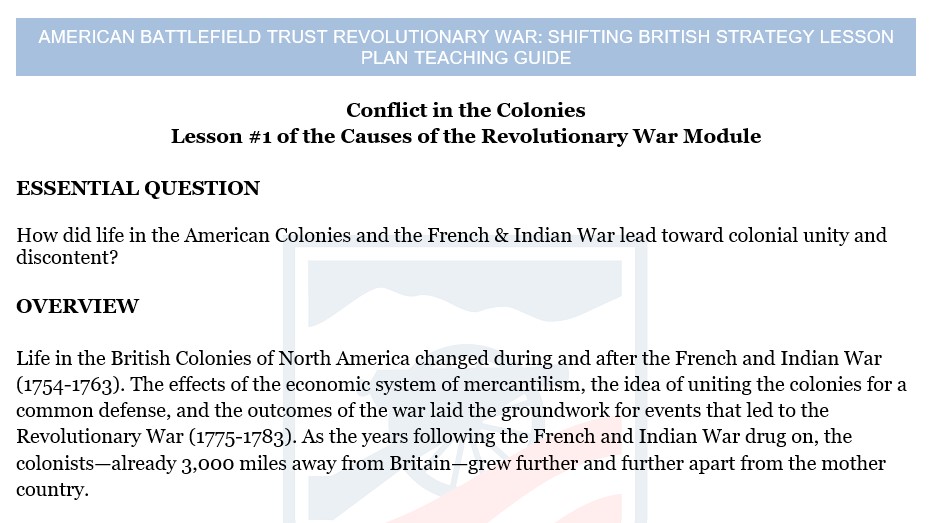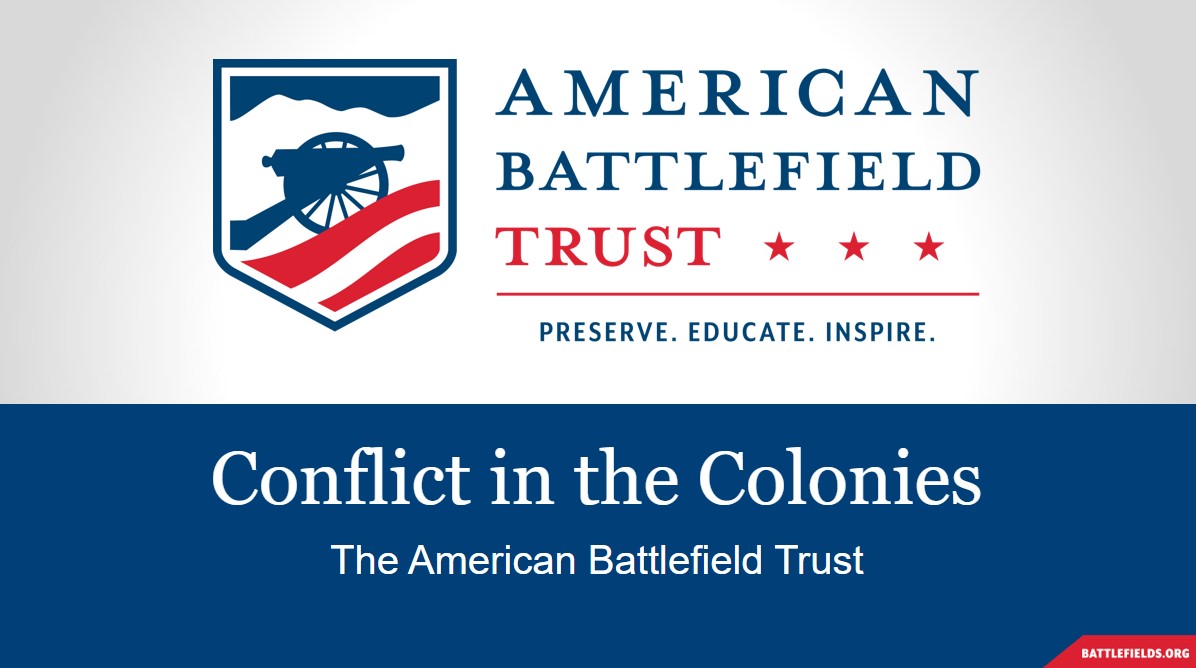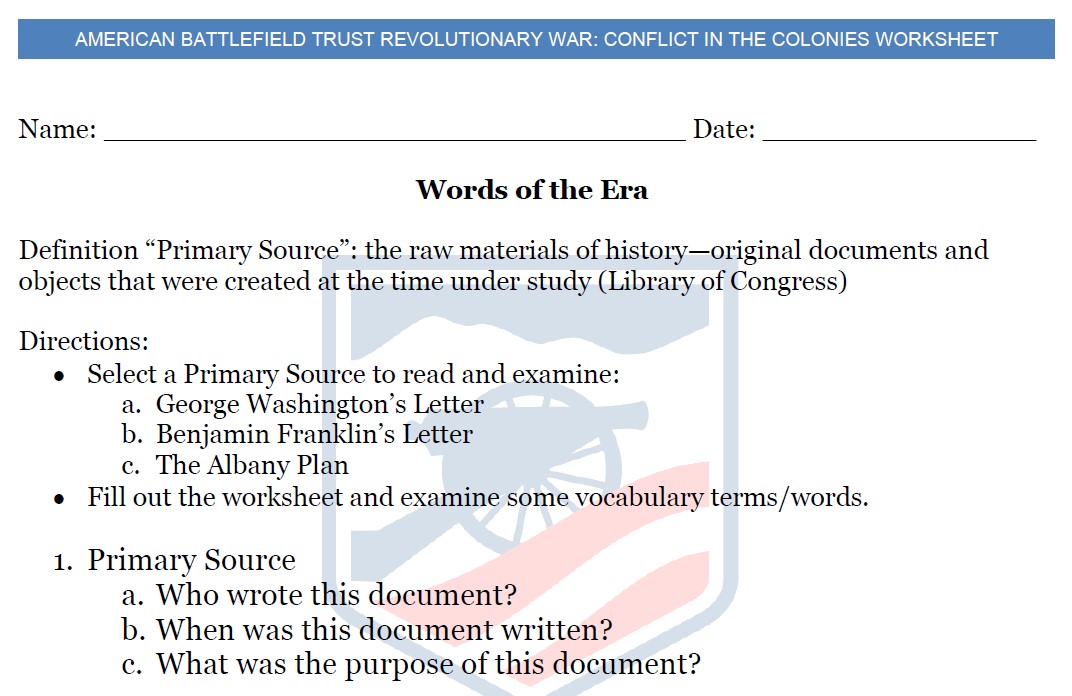
Conflict in the Colonies Lesson Plan
A lesson plan for use in middle and high school classrooms.
Life in the British Colonies of North America changed during and after the French and Indian War (1754-1763). The effects of the economic system of mercantilism, the idea of uniting the colonies for a common defense, and the outcomes of the war laid the groundwork for events that led to the Revolutionary War (1775-1783). As the years following the French and Indian War drug on, the colonists—already 3,000 miles away from Britain—grew further and further apart from the mother country.
This Lesson Plan can be used as a prepared resource by following this curriculum plan which aligns to NCSS and Common Core Standards.
This Lesson Plan's assets can also be used on their own as supplemental resources. The display format is prepared for easy access, exploring, and learning.
Causes of the Revolutionary War Module
Upon completion of this lesson, the students will be able to:
1. Knowledge
- Explain the British reasons for keeping the North American colonies and how they defended them during the Seven Years War.
- Discuss how the French and Indian War increased British colonial holdings and also laid the groundwork for ideas of uniting the American colonies.
2. Comprehension/Application/Analysis
- Read through primary source documents and study vocabulary words in context.
3. Evaluation
- Evaluate the how the French and Indian War began to change life in Colonial America and laid the groundwork for future, increased taxation and thoughts of unity and independence.
Check out the Lesson Plan Teaching Guide for more instructions on using the prepared Lesson Plan.
Lesson Plan Primary Source Activity:
- Use the Lesson’s PowerPoint to explore the context and history; the PowerPoint introduces Essential Questions and lays foundational knowledge about the conflict.
- Read the Secondary Source “10 Facts: The French and Indian War”
- Students will choose a Primary Source and fill out the provided worksheet (see below for Primary Source links).
- Distribute the primary source worksheet and have the students read the provided primary sources for this lesson. Students may work on their own or as a group.
- Students may present their conclusion written or verbally.
- 6 selected primary sources are available under the “Primary Source” section this lesson plan page. However, the following three are recommended as most suitable for the activity:
OPTIONAL HOMEWORK/ASSESSMENT/ADDITIONAL ACTIVITIES:
Option 1: Colonial Life
Students can explore life in Colonial America. These secondary source articles may be helpful:
Everyday Life in Colonial America
Life in Colonial America Prior to the Revolutionary War
Have the students consider some of the positive and negative effects of colonial life. Were there different positives and negatives for different ethnic groups? Different positives and negatives for men, women, and children? Did being colonies of Britain provide a stability or a restriction on common life? Encourage a classroom discussion or for the students to write a short essay with their findings and opinions.
Option 2: Biographies
Students read the selected biographies related to this lesson plan and answer the question with a written paragraph or short essay addressing: “What did this individual do during the Colonial Era and/or French and Indian War? At the time, was he in favor of the colonial system?” Selected biographies are listed here.
Common Core State Standards- ELA & History/Social Studies
Grades 6-8
- Key Ideas & Details:
- CCSS.ELA-LITERACY.RH.6-8.2
- Determine the central ideas or information of a primary or secondary source; provide an accurate summary of the source distinct from prior knowledge or opinions.
- CCSS.ELA-LITERACY.RH.6-8.2
- Craft & Structure:
- CCSS.ELA-LITERACY.RH.6-8.4
- Determine the meaning of words and phrases as they are used in a text, including vocabulary specific to domains related to history/social studies.
- CCSS.ELA-LITERACY.RH.6-8.4
Grades 9-10
- Key Ideas & Details:
- CCSS.ELA-LITERACY.RH.9-10.1
- Cite specific textual evidence to support analysis of primary and secondary sources, attending to such features as the date and origin of the information.
- CCSS.ELA-LITERACY.RH.9-10.1
- Craft and Structure:
- CCSS.ELA-LITERACY.RH.9-10.4
- Determine the meaning of words and phrases as they are used in a text, including vocabulary describing political, social, or economic aspects of history/social science.
- CCSS.ELA-LITERACY.RH.9-10.4
Grades 11-12
- Key Ideas & Details:
- CCSS.ELA-LITERACY.RH.11-12.1
- Cite specific textual evidence to support analysis of primary and secondary sources, connecting insights gained from specific details to an understanding of the text as a whole.
- CCSS.ELA-LITERACY.RH.11-12.1
- Craft and Structure:
- CCSS.ELA-LITERACY.RH.11-12.4
- Determine the meaning of words and phrases as they are used in a text, including analyzing how an author uses and refines the meaning of a key term over the course of a text (e.g., how Madison defines faction in Federalist No. 10).
- CCSS.ELA-LITERACY.RH.11-12.5
- Analyze in detail how a complex primary source is structured, including how key sentences, paragraphs, and larger portions of the text contribute to the whole.
- CCSS.ELA-LITERACY.RH.11-12.4
Social Studies - National Council for the Social Studies
- Theme 1: Culture
- Theme 2: Time, Continuity, and Change
- Theme 3: People, Places, and Environments
- Theme 5: Individuals, Groups, and Institutions
- Theme 6: Power, Authority, and Governance
- Theme 9: Global Connections
This Lesson plan
contains the following:
3 Activities | 19 Resources
Audience: Middle school | High school
This Lesson plan is a part of:
Revolutionary War Curriculum | Causes of the Revolutionary War Module



